热液蚀变过程中的流体性质和元素活动性研究对于认识矿物稳定性、流体演化与成矿机理等方面具有重要意义(Alderton et al., 1980; Baker, 1985; MacLean, 1988; Terakado and Fujitani, 1998; Li et al., 2013; 王翠云等,2012;祁冬梅等,2015) 。因此,前人对不同性质流体中元素的地球化学行为进行过大量研究(Blackburn et al., 1994; Valsami-Jones and Ragnarsdóttir, 1997; Michard, 1989; Wood, 1990; Jiang et al., 2003; Takahashi et al., 2004; Pirajno, 2012; Sun et al., 2015) 。例如,Michard (1989) 的研究结果显示热液中的REE含量会随着pH的降低而增加,而与围岩类型及蚀变温度关系不大。同时,当热液具有高温、pH小于7且富Cl特征时,热液的REE分配模式常常显示Eu正异常特征(Michard, 1989) 。富F的热液能与大部分的REE和Zr元素形成复杂的氟化物,造成相关元素迁移与活化(Watson and Harrison, 1983; Charoy and Raimbault, 1994; Aja et al., 1995; Salvi and Williams-Jones, 1996) 。热力学计算结果还表明,除了能和F元素结合形成更稳定的氟化物外,Ti、Zr和P等元素本身在蚀变过程中容易形成含稀土的副矿物并发生活化迁移(Alderton et al., 1980) 。Jiang et al.(2003) 对华北水泉沟蚀变正长岩的研究结果显示大部分的高场强元素(HSFE),特别是Nb、Zr、REE和Y元素在具有富碱和F特征的流体作用下表现出较强的活动性。然而,Terakado and Fujitani (1998) 对蚀变酸性火山岩的研究则发现,REE和Th、Hf以及Zr等微量元素在强酸性热液流体作用下仍然保持其相对稳定性。
对于不同矿物组合类型的蚀变,前人有针对性地研究过元素活动性和流体演化特征。Alderton et al.(1980) 对西英格兰花岗岩的研究显示,在钾化过程中,三价REE会发生强烈的活化迁移;在绢英岩化过程中,Eu元素会大量的活化迁出;而在电气石化过程中,REE整体显示出迁出特征。在钠长石化阶段,蚀变岩石中的REE含量相对升高而Ti、Al、P和Y元素表现出相对不活动性(Baker, 1985) 。在石英-绿泥石化阶段,LREE会大量迁入而HREE却保持相对稳定性,造成蚀变岩石的(La/Yb)N比值极大升高(MacLean, 1988) 。以上研究结果表明热液系统中的元素地球化学行为非常复杂,没有适用于广泛范围的简单规则。因此,对不同性质热液系统下元素迁移行为的研究是更好的理解热液系统中元素地球化学行为的必要条件。
一般来说,叶蜡石常常产出于富铝质岩石中,可分为低级变质成因(Zen, 1961; Sharma, 1979; Evans and Guggenheim, 1988)和热液成因(Hildebrand, 1961; Brown et al., 2006) 两大类。叶蜡石主要由高岭石或绢云母经低级变质或蚀变作用而成,反应方程式如下:

|
根据Hemley et al.(1980) 对Al2O3-SiO2-H2O体系的实验结果,流体中SiO2的含量控制了叶蜡石和高岭石从体系中的沉淀, 当流体中含有较高数量的溶解Si时,叶蜡石将优先形成。Johnson et al.(1992) 也曾根据其平衡图解提出,在高Si、低pH值条件下,叶蜡石将优先于高岭石而形成。
五台白云叶蜡石矿位于华北克拉通中北部五台县北20km。其围岩隶属于晚太古代五台杂岩,主要为绿片岩相酸性火山岩,岩性为绢云钠长石英片岩夹有少量的绿泥钠长片岩。矿区内蚀变分带明显,可分为早期的黄铁绢英岩化和晚期的叶蜡石化,并在黄铁绢英岩化带内发育金矿化,这为研究叶蜡石化蚀变过程中元素的活动性及其蚀变流体物理化学性质提供了有利条件。为此,本文主要从叶蜡石化蚀变过程所引起的矿物组合及岩石地球化学变化特征等方面入手,通过对叶蜡石矿石与围岩绢云钠长石英片岩的主、微量元素分析,探讨叶蜡石化蚀变过程中元素的活动性与流体性质。
1 区域地质五台-恒山-阜平地区位于华北克拉通中北部,是华北克拉通北缘一带较为典型的晚太古代花岗-绿岩带。区域上五台杂岩与阜平杂岩以龙泉关韧性剪切带相隔,与恒山杂岩以滹沱河相分隔(白瑾,1986;李江海和钱祥麟,1991;田永清,1991;Sun et al., 1992;田永清等,1998;Kröner et al., 2004, 2005;Wilde et al., 2005;Zhao et al., 2007; Wang, 2009;Zhang et al., 2009;图 1a, b)。恒山杂岩和阜平杂岩是由晚太古代到早元古代灰色英云闪长岩-奥长花岗岩-花岗闪长岩(TTG)、基性麻粒岩以及火山-沉积岩组成,变质程度达到了角闪岩相至麻粒岩相(Zhao et al., 2001; Kröner et al., 2005) 。五台杂岩由晚太古代到早元古代的花岗岩类岩石及变质火山-沉积岩组成,后者通常被划分为五台群和滹沱群(图 1b;白瑾,1986;田永清等,1998;Zhao et al., 2001; Kröner et al., 2004) 。依据岩性及变质级别的不同,前人曾将五台群分为上中下三个亚群 (白瑾,1986;李继亮等,1990;苗培森等,1999) :下亚群(石咀亚群)包括橄榄岩、大洋拉斑玄武岩、英安岩、条带状硅铁建造和角闪岩等,变质程度为角闪岩相。其中的橄榄岩、大洋拉斑玄武岩及硅质岩组合被认为代表了残余的洋壳,而其他的沉积岩则代表了大陆或弧后盆地的沉积物(李继亮等,1990;吴昌华和钟长汀,1998) 。Wilde et al.(2004) 从石咀亚群的变质安山岩中获得了2529±10Ma和2513±8Ma两组锆石SHRIMP年龄,并以此推断该亚群的火山岩形成于2529~2513Ma之间。依据石咀亚群出露的大量具有安山岩地球化学特征的方辉橄榄岩及纯橄岩、条带状含铁建造和块状硫化物,Polat et al.(2005) 认为石咀亚群应形成于具有弧前盆地特征的沉积环境。同时,来自该亚群的变质沉积岩地球化学特征及碎屑锆石特征也表明其沉积环境具有弧前或弧内盆地特征(王凯怡等,2000;Li et al., 2008;钱加慧等,2013) 。而Liu et al.(2016b)依据石咀亚群变沉积岩地球化学及年代学特征提出石咀亚群应形成于洋内弧后盆地环境。中亚群(台怀亚群)主要由绿片岩相变质的酸性火山岩及拉斑玄武岩组成(白瑾,1986) 。Liu et al.(1985) 最早从该亚群角斑岩的锆石中获得了一组2520±17Ma锆石年龄。近年来,对于台怀亚群的年代学研究取得了很大进展。Wilde et al.(2004) 从台怀亚群的变质酸性火山岩中获得了2533±8Ma和2516±10Ma两组锆石SHRIMP年龄。最近,Liu et al.(2016a)又从该亚群的变质酸性火山岩中获得了一组2548~2538Ma锆石LA-ICP-MS年龄。基于台怀亚群变质火山岩的地球化学特征,Wang et al.(2004) 认为台怀亚群沉积环境具有弧后盆地特征。依据台怀亚群变沉积岩地球化学及年代学特征,Liu et al.(2016b)提出该亚群应形成于洋内弧后盆地环境。上亚群(高凡亚群)主要由经历了低绿片岩相变质作用的砂岩、粉砂岩及少量的镁铁质到长英质火山岩所组成(白瑾,1986;田永清,1991) 。Wilde et al.(2004) 从该亚群的长英质片岩中获得了一组2528±6Ma锆石SHRIMP年龄。前人曾将五台群上中下三个亚群作为一个完整的地层层序来看待,但是,SHRIMP锆石年代学研究表明五台群不同层位的中酸性火山岩都形成于2530~2515Ma。这些年代学数据说明前人所认为的具有上下层位的石咀、台怀和高凡亚群为几乎同时形成的火山-沉积岩组合,很有可能是后期构造活动将其肢解后又沿着北东-南西向韧性剪切带并置在一起的(Wilde et al., 2004; Wilde and Zhao, 2005; Kröner et al., 2004) 。然而,Wan et al. (2010) 在高凡亚群中获得了2.47Ga的碎屑锆石年龄,认为高凡亚群应形成于早元古代。Liu et al. (2016b)在高凡亚群中获得了2.35Ga的碎屑锆石年龄,也认为高凡亚群应形成于早元古代。

|
图 1 恒山-五台-阜平地区地质简图(据白瑾等,1992修改),插图展示了华北克拉通相对位置 Fig. 1 Simplified geological map of the Hengshan-Wutai-Fuping area (modified after Bai et al., 1992), inset shows the location of the North China Carton (NCC) |
滹沱群主要分布在五台群西南部,是一套经历了低绿片岩相变质作用的碎屑岩和碳酸盐岩组合,不整合覆盖在五台花岗岩、五台群以及阜平杂岩之上(图 1b)。滹沱群底部的长英质凝灰岩、玄武-安山质熔岩和砂岩的锆石U-Pb年龄结果表明其沉积时代为2140±14Ma且被认为与2.2~2.1Ga的华北克拉通的伸展活动有关(Du et al., 2010; 杜立林等,2011) 。
区域上花岗质岩石占五台杂岩出露区面积的三分之一(白瑾,1986;图 1b),岩石类型主要为花岗闪长岩和二长花岗岩,其侵入时代大体可分为三期:(1) 2.56~2.52Ga侵入的英云闪长岩-奥长花岗岩-花岗闪长岩(TTG),片理发育(Wilde et al., 1997, 2005),地球化学和Nd同位素特征表明其形成于岛弧环境(Liu et al., 2004) ;(2) 2.18~2.08Ga侵入的弱变形正长斑岩(Wilde et al., 2005; Du et al., 2013) ;(3) 1.8Ga侵入的未变形花岗岩(白瑾等,1992) 。除此以外,区域上还发育有多期次的镁铁质辉绿岩墙,时代可从元古代延续至中生代(Chen and Zhai, 2003; Peng et al., 2005) 。
2 矿区地质2.1 叶蜡石矿特征白云叶蜡石矿床为一新近发现并开采的矿床,矿区内主要出露五台群台怀亚群绢云钠长石英片岩,夹有少量的绿泥钠长片岩(图 2、图 3) 。其中叶蜡石主矿体近东-西向呈透镜状产出于绢云钠长石英片岩的裂隙中,其东西轴长约5km,南北最宽处约1km,且向东、西两侧逐渐变窄,最窄处仅10m左右,该矿体深部延伸较长,未见底;矿体倾向西北,倾角较陡,倾向平均为335°,与绢云钠长石英片岩产状基本一致。矿区内岩浆活动强烈,包括晚太古代TTG、辉长岩及多期次的镁铁质岩墙均有出露(图 2) 。在叶蜡石矿主矿体北部可见一镁铁质辉绿岩墙切穿了主矿体(图 2、图 4d)。该岩脉宽约2m,走向近东西向。然而,该岩墙中锆石数量稀少,无法获得可靠的锆石U-Pb年龄,需进一步准确的定年工作。在矿区南部可见滹沱群沉积砂岩与绢云钠长石英片岩呈断层接触(图 2) 。
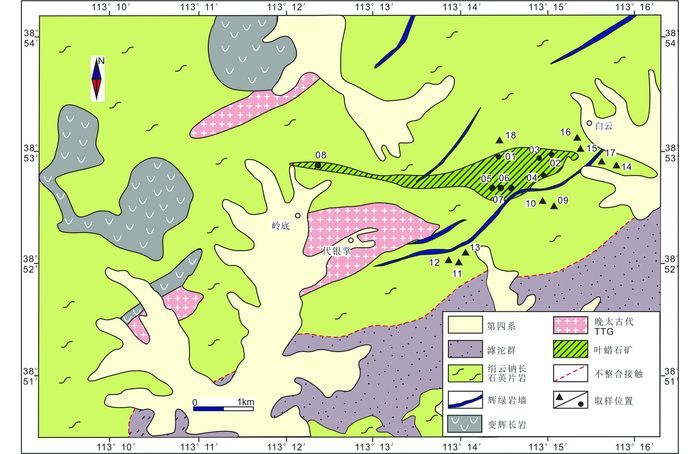
|
图 2 山西五台白云叶蜡石矿区地质图(据山西省第三地质工程勘察院,2013①修改) 黑色圆圈为叶蜡石矿石取样点,黑色三角为绢云钠长石英片岩取样点,具体编号请见表 1 Fig. 2 Geological map of the Baiyun pyrophyllite deposit in Wutai County, Shanxi Province The black circles are sampling points of pyrophyllite ores; the black triangles are sampling points of albite-sericite quartz schists. The relevant numbers are marked on Table 1 |
① 山西省第三地质工程勘察院.2013. 山西省五台县豆村幅1:5万区域地质图
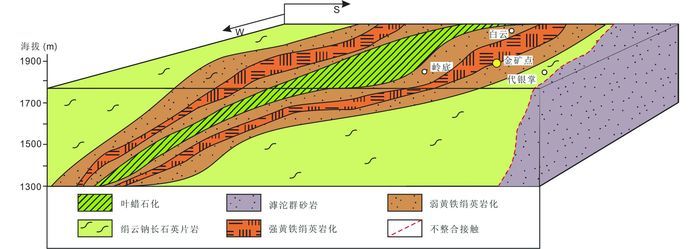
|
图 3 五台白云叶蜡石矿区蚀变分带图 Fig. 3 Alteration map of the Baiyun pyrophyllite deposit in Wutai County, Shanxi Province |
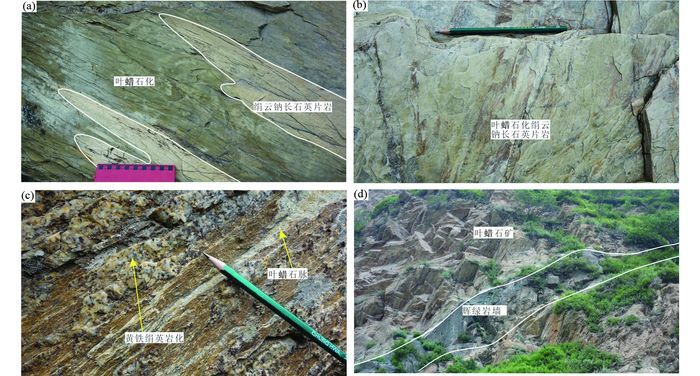
|
图 4 山西白云叶蜡石矿野外地质及蚀变特征 (a、b)叶蜡石矿体中残留的围岩绢英钠长石英片岩;(c)叶蜡石热液细脉侵入金矿化的黄铁绢英岩;(d)镁铁质辉绿岩墙侵入叶蜡石主矿体 (走向180°) Fig. 4 Field geology and alteration characteristics of the Baiyun pyrophyllite deposit, Shanxi province (a, b) weak altered wall rocks of albite-sericite quartz schists in pyrophyllite orebodies; (c) pyrophyllite veinlet cutting through gold mineralized albite-sericite quartz schists; (d) a mafic dyke intruded the pyrophyllite deposit with a strike of 180° |
矿区内蚀变现象较为发育,类型主要有叶蜡石化、黄铁矿化、绢云母化与硅化,其中绢云母化常与黄铁矿化、硅化密切伴生形成黄铁绢英岩化(图 3、图 4a-c)。近矿围岩蚀变以叶蜡石化为主,部分叶蜡石矿石蚀变不完全而保留有绢云钠长石英片岩的特征(图 4a, b)。黄铁绢英岩化主要发育于叶蜡石化两侧,且矿化在叶蜡石矿南北两侧呈现弱-强-弱的蚀变分带,空间上呈带状展布(图 3) 。早期的黄铁绢英岩化蚀变矿物组合以绢云母、石英及少量的黄铁矿、黄铜矿等金属硫化物组成(图 5),局部金矿化强烈。晚期叶蜡石化蚀变主要位于绢云钠长石英片岩的断裂带附近,其两侧黄铁绢英岩化呈带状展布,矿物组合主要为叶蜡石、伊利石和少量的高岭石等粘土类矿物。叶蜡石中金属硫化物颗粒细小且含量很低,部分有溶蚀现象且广泛发育赤铁矿化(图 5n, o)。
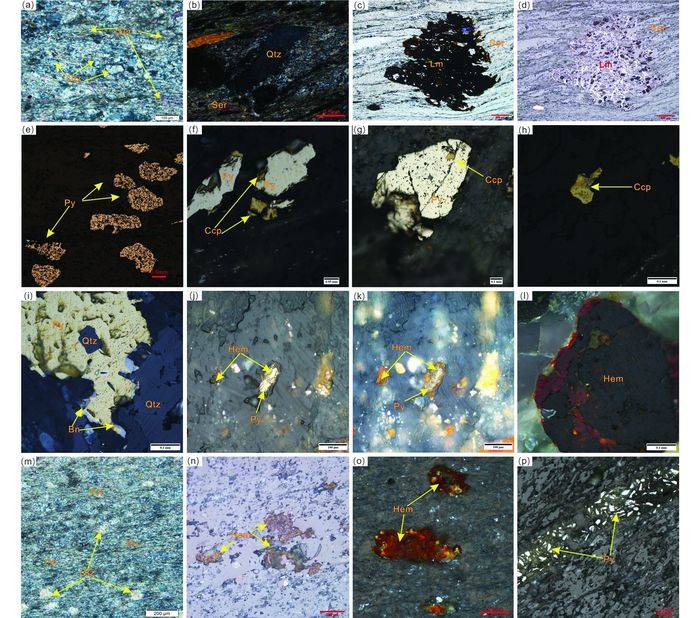
|
图 5 绢云钠长石英片岩和叶蜡石显微特征 (a、b)区域变质作用形成的绢云母和石英均发育强烈的变形作用;(c、d)区域变质作用形成的黄铁矿多风化为褐铁矿并发育大量的裂隙(c为正交偏光镜下,d为反光镜下);(e-h)黄铁绢英岩化蚀变作用形成大量金属硫化物,无变形;(i-l)相对靠近叶蜡石矿体的黄铁绢英岩中可见:(i)斑铜矿伴生于黄铁矿边缘,(j、k)黄铁矿外围包裹有赤铁矿,(l)黄铁矿被完全氧化为赤铁矿;(m)叶蜡石矿石中细小的不规则石英颗粒及具有鲜艳干涉色的纤维状叶蜡石;(n、o)叶蜡石中发育的港湾状赤铁矿;(p)叶蜡石矿石中的晚期石英-黄铁矿脉,黄铁矿表面新鲜,无氧化.矿物缩写据Whitney and Evans (2010) :Prl-叶蜡石;Ser-绢云母;Ab-钠长石;Qtz-石英;Pl-斜长石;Lm-褐铁矿;Cal-方解石;Py-黄铁矿;Ccp-黄铜矿;Bn-斑铜矿;Hem-赤铁矿 Fig. 5 Micrographs of the albite-sericite quartz schists and pyrophyllite ores (a, b) sericite and quartz formed by regional metamorphism were strongly deformed; (c, d) pyrite formed by regional metamorphism were weathered into limonite and developed lots of fractures, with only morphology of pyrite left; (e-h) amounts of metal sulfides were formed under the pyrite-pyllic alteration, with little deformation; (i-l) pyrite-phyllic altered albite-sericite quartz schists closed to the pyrophyllite orebodies: (i) bornite was formed along the edge of pyrite from the pyrite-pyllic altered albite-sericite quartz schists, (j, k) pyrite was surrounded by hematite, (l) pyrite was completely oxidized into hematite; (m) the small irregular quartz particles and fibrous pyrophyllite with bright interference in the pyrophyllite ores; (n, o) harbor-shaped hematite in the pyrophyllite ores; (p) non-oxidized pyrite in the late quartz-pyrite veins, cutting through the pyrophyllite ores. Mineral abbreviations after Whitney and Evans (2010) : Prl-pyrrhotite; Ser-sericite; Ab-albite; Qtz-quartz; Pl-plagioclase; Lm-limonite; Cal-calcite; Py-pyrite; Ccp-chalcopyrite; Bn-bornite; Hem-hematite |
早期区域变质作用将2.55~2.50Ga喷发的酸性火山岩蚀变为绢云母+钠长石+石英的组合并含少量的黄铁矿(图 5a-d)。该期形成的石英颗粒细小,定向排列,绢云母变形强烈(图 5a, b);该阶段的黄铁矿含量少且显示出韧性剪切变形特征,发育大量裂隙,并多风化为褐铁矿(图 5c, d)。晚期金矿化的黄铁绢英岩叠加在绢云钠长石英片岩之上,发育大量金属硫化物(图 5e-h),主要为黄铁矿与黄铜矿。在相对远离叶蜡石矿体的黄铁绢英岩中可见黄铜矿伴生于黄铁矿周围(图 5f)或镶嵌于黄铁矿内部(图 5g)以及单独形成黄铜矿颗粒(图 5h),表面新鲜,无氧化现象(图 5e-h)。然而,在靠近叶蜡石矿体的绢云钠长石英片岩中偶见斑铜矿伴生于黄铁矿颗粒边缘(图 5i),部分黄铁矿颗粒表面破碎明显,边缘有被溶蚀的现象,还可见黄铁矿有赤铁矿化现象(图 5j-l)。全岩地球化学分析结果表明位于强弱黄铁绢英岩化分带处的绢云钠长石英片岩Au含量可达18×10-6,数据显示金矿化主要集中在黄铁绢英岩化带内,且位于强-弱黄铁绢英岩化分带处(图 3) 。
叶蜡石矿物镜下颗粒十分细小,集合体呈纤维状、鳞片状(图 5m)。石英为不规则粒状,矿物边界无完整晶面,呈他形产出(图 5m)。在叶蜡石化过程中,大部分黄铁矿颗粒十分细小,并受蚀变流体影响而氧化成为赤铁矿,边缘因流体溶蚀呈港湾状(图 5n, o),未见其它金属硫化物,如黄铜矿、斑铜矿等。而切穿叶蜡石矿石的晚期石英-黄铁矿脉中发育大量新鲜的黄铁矿,边缘较为平直,且未受到明显的赤铁矿化(图 5p)。
3 样品分析测试方法XRD粉晶衍射在中国地质大学(北京)地学实验中心X射线衍射粉晶实验室完成,仪器型号为SmartLab,使用Cu靶,石墨单色器,电压40kV,电流100mA。扫描速度为8°/min,扫描范围是0~70°,步宽0.02°。
岩石主、微量元素分析在加拿大温哥华Acme分析实验室完成。详细的样品处理和分析方法为:准确称取0.20g粉末样品,将其与1.50g LiBO2助熔剂放置于石墨坩埚内进行充分混合。将样品/助熔剂的混合物于马弗炉上在1050℃的温度下加热15min。提取熔融后的混合物,倒入100mL由去离子水和ACS级纯度硝酸配置的5%浓度的HNO3中。将溶液摇晃2h使其充分溶解,取其一部分置入聚丙烯分析管内,主量元素通过采用X射线荧光光谱法(XRF)进行分析,微量元素采用电感耦合等离子体质谱分析(ICP-MS)进行分析。对于金属元素的分析,称取0.50g用品,置于3mL高温的(95℃)王水中进行溶解后,通过ICP-MS进行分析。主量元素单位为wt%。微量元素单位为×10-6。金属元素中除Au单位为×10-9,其他为×10-6。所有元素分析精度优于3%。
4 结果4.1 XRD粉晶衍射结果XRD粉晶衍射分析结果显示叶蜡石矿石中除主要矿物叶蜡石外,还含有伊利石、高岭石等粘土矿物及石英、绢云母等蚀变残余矿物(图 6) 。
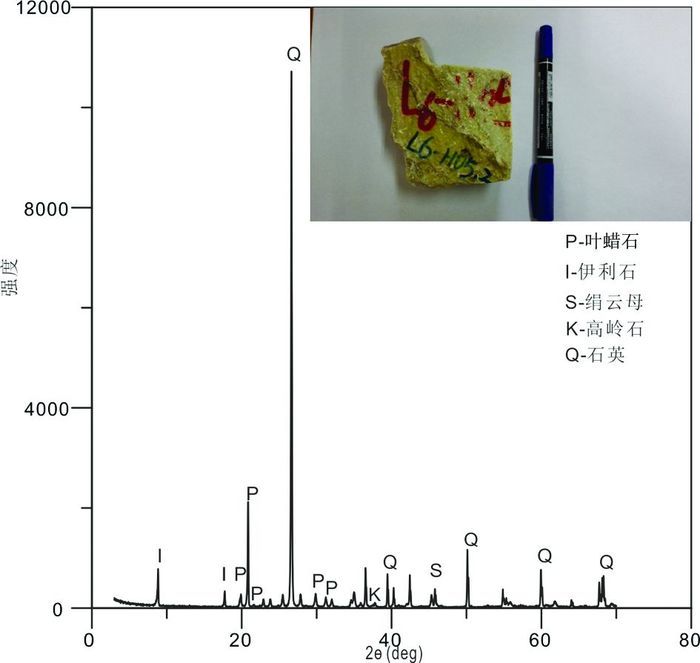
|
图 6 叶蜡石矿石XRD粉晶衍射图谱 Fig. 6 XRD analyses of pyrophyllite ores |
叶蜡石矿石及围岩绢云钠长石英片岩的主、微量元素分析结果列于表 1。
|
|
表 1 叶蜡石矿石及绢云钠长石英片岩的主量元素(wt%)、微量元素(×10-6)分析结果 Table 1 The major (wt%) and trace (×10-6) elements of pyrophyllite ores and albite-sericite quartz schists |
叶蜡石矿石的SiO2含量变化范围为74.41%~78.31%,K2O含量为2.27%~4.63%,Na2O含量为1.03%~4.97%。围岩绢云钠长石英片岩中的SiO2含量为62.80%~74.30%,K2O含量为0.98%~3.28%,Na2O含量为0.65%~2.50%。在叶蜡石化过程中,SiO2、K2O和Na2O的含量均有不同程度的提高,且Na2O/K2O比值平均值从0.7(围岩)上升到1.0(叶蜡石矿石),略有升高(表 1) 。在TiO2、CaO、Fe2O3T、MgO和P2O5含量方面,叶蜡石分别为0.04%~0.12%、0.03%~0.42%、0.44%~0.64%、0.10%~0.19%和0.02%~0.10%,均低于围岩绢云钠长石英片岩中相应氧化物的含量(0.21%~0.66%、0.22%~4.64%、1.80%~6.42%、0.15%~2.99%和0.05%~0.20%;表 1) 。
4.3 微量元素叶蜡石矿石与围岩绢云钠长石英片岩的微量与稀土元素特征整体趋势一致,但部分元素有明显差异。在球粒陨石标准化稀土元素配分图中(图 7a),绢云钠长石英片岩的轻稀土含量较高,呈现从La到Eu逐渐降低的趋势,具有较高的(La/Yb)N比值(8~26) (图 8a)和相对低的(Gd/Yb)N比值(2~3),轻重稀土分馏明显。Eu稍显负异常(0.78~0.97) 。叶蜡石矿石中轻稀土元素含量仍比重稀土高,但轻重稀土分馏程度降低,具有相对较低的(La/Yb)N比值(5 ~10)和(Gd/Yb)N比值(1~2) 。Eu负异常明显增大(0.1~0.3) 。

|
图 7 叶蜡石与绢云钠长石英片岩球粒陨石标准化稀土元素配分图(a)和原始地幔标准化微量元素蛛网图(b)(标准化值据Sun and McDonough, 1989) Fig. 7 Chondrite-normalized REE patterns (a) and primitive mantle-normalized trace elements spider diagrams (b) for pyrophyllite ores and the albite-sericite quartz schists (normalization values after Sun and McDonough, 1989) |
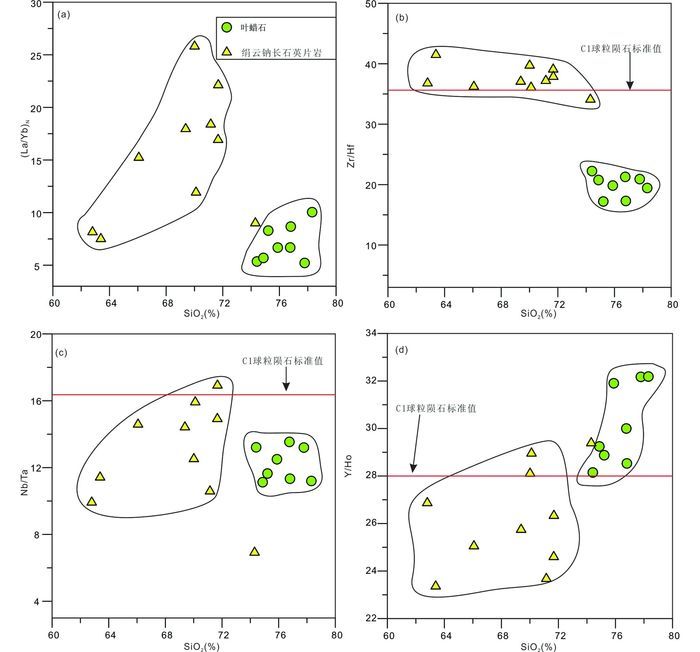
|
图 8 叶蜡石与绢云钠长石英片岩(La/Yb)N (a)、Zr/Hf (b)、Nb/Ta (c)和Y/Ho (d)比值与SiO2二维图解(球粒陨石标准化值及C1球粒陨石值据Sun and McDonough, 1989) Fig. 8 The element ratio diagrams of (La/Yb)N (a), Zr/Hf (b), Nb/Ta (c) and Y/Ho (d) vs. SiO2 for pyrophyllite and albite-sericite quartz schists (normalization values and C1 chondrite from Sun and McDonough, 1989) |
在原始地幔标准化微量元素蛛网图中(图 7b),叶蜡石矿石与围岩绢云钠长石英片岩样品均具有相对亏损P和Ti元素特征。其中,叶蜡石相对于绢云钠长石英片岩明显亏损Sr、Ba、Zr和Hf元素。叶蜡石矿石的Zr/Hf比值(Zr/Hf=17~22) 相对于绢云钠长石英片岩(Zr/Hf=34~42) 明显降低(图 8b)。叶蜡石中的Nb和Ta含量相对绢云钠长片岩有所升高,Nb/Ta比值从10~17(围岩绢云钠长石英片岩)变化到11~13(叶蜡石矿石;图 8c)。而叶蜡石中的Y含量(9.7~23.1) 相对于绢云钠长石英片岩(5.3~26.4) 变化不大,表现出相对稳定性,但Y/Ho比值从23~29(绢云钠长石英片岩)变化到28~32(叶蜡石),相对升高(图 8d)。
4.4 金属元素叶蜡石中的金属元素除Cu、Pb和Zn外,大部分均低于检测限。绢云钠长石英片岩中的金属元素含量相对于叶蜡石来说整体偏高,且显微镜下具有较多金属硫化物(主要为黄铁矿)特征的样品中Au含量明显异常高,可达18.2×10-6(样品编号11、12;图 9) 。同时,绢云钠长石英片岩中的Au与As含量之间呈现明显的正相关性(图 9),与造山型金矿Au与As含量特征类似(Zhu et al., 2011) 。
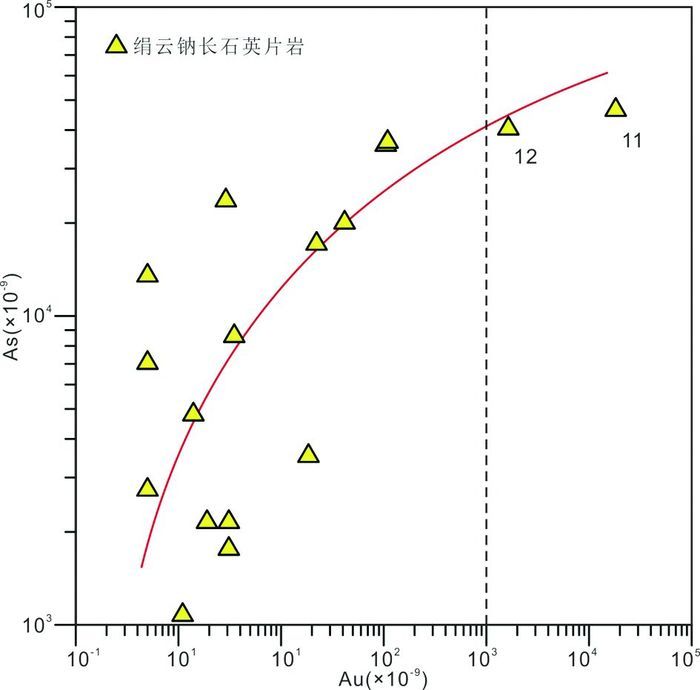
|
图 9 绢云钠长石英片岩中Au与As含量相关性图解 Fig. 9 The Au and As correlation contents of albite-sericite quartz schists |
成矿流体与围岩相互作用导致围岩蚀变,其在微观上表现为元素的带入、带出,质量平衡分析可以定量的研究蚀变过程中的元素迁移(Gresens, 1967; Grant, 1986, 2005) 。Gresens (1967) 在考虑了岩石成分和体积的关系之后,提出了Gresens计算公式和相应的成分-体积图解法,Grant (1986) 对该方程进行了简化,采用等浓度图解法(即Isocon图解法)来接近。因此,在系统中存在两个或两个以上的不活动元素研究蚀变系统中的元素迁移,成为研究元素迁移的经典方法。因此,本文采用等浓度图解法(即Isocon图解法)来揭示主微量元素在热液蚀变过程中的迁移行为。
其基本公式为:

|
(1) |
式中ΔC为蚀变前后元素组分浓度的迁移量,MP、MA为蚀变前后的岩石质量。岩石中不活动元素中ΔC=0,公式变化为

|
(2) |
式中:Cai为不活动元素i在蚀变岩中的含量;Cpi为不活动元素i在原岩中的含量。其直线斜率为:

|
(3) |
式(3) 是一穿过原点斜率为MP/MA的直线,即Isocon线。将式(5) 带入式(3) 得:

|
(4) |
由式(4) 即可求得元素迁入迁出量ΔC,结果列于表 1。
根据式(4) 就可求得元素的迁入迁出变化。在Ca-Cp图解中,通过元素m投点位置与不活动元素i的Isocon线位置相对关系,在Isocon线以上为迁入,在Isocon线以下为迁出,与Isocon线距离越大迁入迁出程度越强。
因此,确定蚀变过程中的不活动元素是蚀变岩元素质量平衡计算的关键(郭顺等,2013) 。而目前确定系统中不活动元素的方法主要有Isocon图解法(Grant, 1986) 、坪台法(Gong et al., 2011) 与经验判断法。Isocon图解法假设系统中存在多个不活动元素时,如地球化学行为不同的几个组分能够表现出相同的迁移程度(即投点形成一条近似穿过原点的直线),则这几个组分的百分含量变化主要受控于体系总体质量的变化,它们均可定义为不活动元素。坪台法认为,不活动元素在原岩与蚀变岩中的比值理论上应相同或比较时,蛛网图中会形成一个坪台。经验判断法是根据蚀变岩的类型,利用已有的地球化学经验来确定系统中的不活动元素。大量的研究表明,在热液蚀变过程中一些元素或氧化物,如,Al2O3、TiO2、Ta、Nb、La、Zr、Hf、Th、Yb和Y显示出相对不活动性(Rubin et al., 1993; Terakado and Fujitani, 1998; Van Dongen et al., 2010; Gong et al., 2011) 。因此,本文首先根据经验选择以上元素或氧化物作为备选,构建绢云钠长石英片岩和叶蜡石矿石的不活动元素蛛网图(图 10a),并确定相对不活动元素或氧化物。图 10a中,U、La、Zr、Hf、TiO2、Yb和Y在叶蜡石化过程中呈逐渐迁出趋势,可视为活动元素。在余下的元素中,Nb和Ta形成一个坪台,由于其地球化学性质相似,可将它们视为协变元素。Al2O3与Th形成一个坪台,但其蚀变岩与原岩的质量比率分别为1.00与0.69,据此判断叶蜡石化过程中,氧化物Al2O3保持相对稳定性。
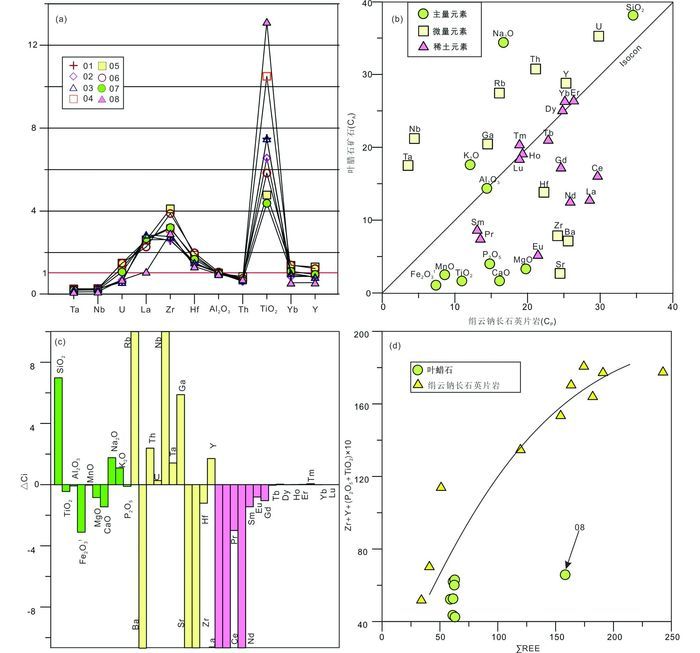
|
图 10 叶蜡石化过程中元素迁移图解 (a)坪台法判别不活动元素蛛网图,图中曲线由叶蜡石备选不活动元素与绢云钠长石英片岩平均值比较得出,图中元素小于1的为相对迁入元素,大于1的为迁出元素;(b)叶蜡石与绢云钠长石英片岩质量平衡迁移及迁移量图;(c)叶蜡石化过程中相应组分的亏损与富集柱状图,迁移量ΔCi计算方法见文章描述;(d)∑REE与含REE矿物指数(Zr+Y+(P2O5+TiO2)×10) 图(据Van Dongen et al., 2010修改) Fig. 10 Elements migration diagrams of pyrophyllite alteration (a) diagram of immobile elements by using method of immobile plateau, the curves acquire the ratio of pyrophyllite and average value from albite-sericite quartz schists, the ratios less than 1 are elements relatively moved in, and those more than 1 are elements relatively moved out; (b) the mass balance diagram of pyrophyllite ores and albite-sericite quartz schists; (c) the histogram of loss and enrichment components. The calculated migration ΔCi was described in the text; (d) the diagram of REE vs. REE index (Zr+Y+(P2O5+TiO2)×10) (modified afrter Van Dongen et al., 2010) |
将黄铁矿化绢云钠长石英片岩(Cp)与叶蜡石(Ca)的元素或氧化物的平均值投入Isocon图解中,可以发现Al2O3与Tb、Dy、Ho、Er、Tm、Yb、Lu等重稀土元素能拟合出一条过原点的直线,说明以上元素或氧化物在蚀变过程中具有相同的迁移程度,即,具有相对不活动性,这与前文所得结论一致。
5 讨论5.1 热液蚀变流体性质与金矿化在热液蚀变过程中,为了使体系达到新的平衡,原有的矿物会发生分解而趋于形成新的稳定矿物。这些新生成的蚀变矿物可以记录水-岩相互作用过程的P-T条件及pH、fO2等信息。为了更好的限定热液蚀变流体的物理化学性质,依据岩相学观察到的硫化物和铁氧化物特征,本文拟构建Fe-S-O-H体系下的Log fO2-pH热力学相图来限定不同蚀变阶段热液蚀变流体的pH与Log fO2范围(图 11) 。叶蜡石化通常出现在过铝质岩石或由热液蚀变引起的其它元素淋滤造成的Al相对富集环境下(Evans and Guggenheim, 1988) 。叶蜡石矿石中较高含量的石英以及XRD粉晶衍射结果所显示的叶蜡石-高岭石-石英等矿物组合特征表明,本文叶蜡石化应存在于Al2O3-SiO2-H2O体系中且发育在石英饱和线以上。结合前人在1kbar水压下Al2O3-SiO2-H2O体系的实验结果(Hemley et al., 1980),说明本文叶蜡石矿化的成矿温度应不超过270℃左右。Seddorff et al.(2005) 的研究结果显示,在浅成低温热液矿床中当温度低于200℃时,矿体中的叶蜡石将完全转变为高岭石。因此,依据本文叶蜡石矿的矿物组合特征,我们将其形成温度限定在200~270℃。另外,前人研究结果显示区域上金矿化的黄铁绢英岩中石英的流体包裹体均一温度介于212~381℃之间,平均值为300℃(卢静,2009) 。因此,我们选择200~300℃的温度范围做为黄铁绢英岩化的蚀变温度,选择1kbar为主要的矿化蚀变压力构建Log fO2-pH热力学相图。溶液的液相组成选用常见的含硫的分子或离子,即HS-、HSO4-、SO42-和H2S,各分子或离子的相变平衡边界线采用Supcrt 92(Johnson et al., 1992;数据库采用slope07.dat,来源于http://geopig.asu.edu/)计算得到的LogK值来限定(表 2) 。五台地区发育有一系列的造山型金矿(田永清等,1998),而造山型金矿成矿热液中溶解硫浓度范围一般为10~10-3.5mol/kg (Mikucki, 1998) 。因此,本文假设叶蜡石化与黄铁绢英岩化蚀变流体的溶解S浓度为0.01mol/kg。同时,区域上黄铁矿化绢云钠长石英片的岩流体包裹体显示黄铁绢英岩化蚀变流体盐度为8.27%(卢静,2009),且流体包裹体的K+/Na+平均值为0.2。所以,本文假设黄铁绢英岩化蚀变流体的Na+离子浓度为1mol/kg,K+离子浓度为0.2mol/kg。而质量平衡迁移结果显示,相对于围岩绢云钠长石英片岩,叶蜡石矿石的K2O含量有所升高,说明叶蜡石化蚀变流体的K+离子浓度应不低于0.2mol/kg。为更清晰地对比两类蚀变流体的物理化学性质,本文暂将叶蜡石化蚀变流体K+离子浓度也定为0.2mol/kg。
|
|
表 2 矿物反应及LogK值 Table 2 Mineral reactions with the LogK values |

|
图 11 Log fO2-pH相图 叶蜡石相区范围由其矿物组合限定,即叶蜡石+绢云母+赤铁矿组合;黄铁矿化绢云钠长石英片岩相区范围由其矿物组合限定,即绢云母+黄铁矿+黄铜矿.矿物缩写据Whitney and Evans (2010) :Ser-绢云母;Prl-叶蜡石;Kfs-钾长石;Py-黄铁矿;Ccp-黄铜矿;Bn-斑铜矿;Hem-赤铁矿;Po-磁黄铁矿;Mt-磁铁矿 Fig. 11 Estimated Log fO2-pH diagram for hydrothermal fluid alteration The phase region of pyrophyllite is defined by the mineral compositions of pyrophyllite, sericite and hematite. The phase region of albite-sericite quartz schists is defined by its mineral compositions of sericite, pyrite and chalcopyrite. Abbreviations after Whitney and Evans (2010) : Ser-sericite; Prl-pyrophyllite; Kfs-K-feldspar; Py-pyrite; Ccp-chalcopyrite; Bn-bornite; Hem-hematite; Po-pyrrhotite; Mt-magnetite |
在相对酸性的环境中,长石易于形成绢云母。当溶液中酸性较强时,生成的绢云母不稳定并最终转化为粘土类矿物(Sverjensky et al., 1991) 。因此,蚀变成因的绢云母就可以有效的约束蚀变流体的pH值。在叶蜡石化蚀变过程中,当pH降低到2.07~2.20附近时,绢云母开始变得不稳定并蚀变为叶蜡石(图 11a, b),说明引起叶蜡石化蚀变的流体为一强酸性流体(pH=2.07~2.20) 。前人实验研究也表明,叶蜡石化主要形成于pH=1.2~3.0和250~290℃的条件下(Sinyakovskaya et al., 2005),与本文的估算结果吻合。
蚀变流体的氧逸度可由岩石中存在的含铁硫化物及氧化物进行有效的限定(图 11a, b)。黄铁矿是黄铁绢英岩化蚀变阶段形成的主要金属硫化物,且常可见黄铜矿与之呈伴生状态(图 5f, g)。在黄铁绢英岩化蚀变阶段形成的黄铁矿、黄铜矿、斑铜矿等硫化物常可见受后期蚀变流体的影响而氧化为赤铁矿(图 5i-l)。叶蜡石矿石中则大部分为赤铁矿,且颗粒十分细小,边缘因流体溶蚀呈港湾状(图 5n, o)。在穿切叶蜡石矿石的晚期热液石英-黄铁矿脉中,可见大量自形的黄铁矿颗粒,未发生明显地赤铁矿化现象(图 5p)。上述总体特征说明,叶蜡石矿石中的赤铁矿应由早期的黄铁矿蚀变而成。在Log fO2-pH热力学相图中,可以发现当Log fO2逐渐升高时,金属硫化物或氧化物组合遵循从黄铁矿+黄铜矿→黄铁矿+斑铜矿→赤铁矿转变这一过程,与叶蜡石矿石和黄铁矿化绢云钠长石英片岩镜下特征吻合。这说明本文叶蜡石化蚀变流体为一较高氧逸度的酸性流体,其氧逸度应在HM缓冲线附近或之上(图 11a, b)。
在热液体系中,金的沉淀主要取决于温度、压力、pH值、Cl-离子浓度及H2S的逸度(Zhu et al., 2011) 。当温度大于400℃时,Au主要以AuCl2-形式在热液体系中运移(Gammons and Williams-Jones, 1997) 。当温度逐渐降低时,Au主要以Au (HS)2-形式运移(Cooke and Simmons, 2000),并且Au的最大溶解度范围存在于H2S-HS--SO42-三相平衡点附近(图 11) 。由于测试的金矿化绢云钠长石英片岩中Au含量范围在1×10-6~18×10-6之间,同时在金矿化较好的绢云钠长石英片岩中常可见黄铁矿与黄铜矿呈伴生状态(图 5i-l)。因此,本文在假设成矿流体Au (HS)2-离子浓度分别为10-8、10-7、10-6和10-5的基础上,将含金黄铁绢英岩化蚀变范围定在Au (HS)2-离子浓度较低,且金属硫化物组合为黄铁矿+黄铜矿组合范围之内(图 11a, b)。在Log fO2-pH相图中,黄铁绢英岩化蚀变流体的pH应在5.24~5.87之间,其氧逸度则明显低于叶蜡石化蚀变流体,应位于黄铁矿+黄铜矿组合范围内(图 11a, b)。而叶蜡石化蚀变流体应为不同物理化学性质的流体叠加在早期的黄铁绢英岩化之上并引起先期富集的金属元素发生迁移。
5.2 热液蚀变过程中的元素迁移由Isocon图解法得到的元素迁入迁出量显示(图 10b, c;表 1),在叶蜡石化蚀变过程中,TiO2、CaO、Fe2O3T、MgO和P2O5均有不同程度的迁出,应与黑云母、磷灰石等矿物的分解有关。SiO2表现为迁入且迁入量较低,主要来源为绢云钠长石英片岩叶蜡石化过程中所形成的细粒石英(图 5m)。随着原岩中绢云母及钠长石等富K+、Na+离子的分解,K+与Na+离子将被大量浸出,造成K2O与Na2O含量的降低。然而,本文叶蜡石的K2O与Na2O的含量却发生明显地增加。Roaldset (1975) 的研究表明离子能以吸附作用的形式固着在层状硅酸盐矿物的表面或含有可交换电价的晶体结构层中。另外,Rusk et al.(2011) 指出热液石英中Al是含量最多的微量元素,当蚀变温度低于300℃时,热液石英相邻生长区域内部Al含量可产生高达2个数量级的差异,且热液石英中的Li、Na、K的含量常常与Al含量呈正相关。因此,叶蜡石矿中大量热液石英的生成对Al含量的相对稳定和K+、Na+离子的升高产生一定影响。尽管如此,石英中的K、Na含量依然是微量元素含量级别,绝不会成为控制叶蜡石矿石中K、Na含量的主因。为此,我们认为本文叶蜡石矿K2O和Na2O含量的升高与蚀变流体较高的盐度有关,另一方面则与粘土矿物的层间吸附作用及伊利石的形成有关。
微量元素中,Ba、Sr、Zr、Hf均呈不同程度的亏损。其中,Sr应主要赋存于钠长石和绢云母中,而Ba则主要赋存于钾长石和云母中(Fourcade and Allegre, 1981; Noyes et al., 1983) 。因此,本文中Sr、Ba的亏损很可能与长石、云母类矿物的分解有关。对于元素Zr和Hf而言,它们主要受控于副矿物锆石(Rubin et al., 1993) 。在太古代至古生代绿片岩相片岩或葡萄石-绿纤石变质相的页岩中,均有碎屑锆石发生次生加大和局部溶解的现象(Dempster et al., 2004; Rasmussen, 2005),说明Zr元素即使在低级变质作用下也具有一定的活动性,应与锆石蜕晶质部分的溶解重结晶有关(Dempster et al., 2004) 。实验结果显示,Zr元素在强酸(pH<3)和强碱(pH>10~12) 性流体中均有较高的溶解度(Sasaki et al., 2006; Brendebach et al., 2007) 。大量的热液锆石在块状硫化物矿床中的发现也证实了这一点(Nesbitt et al., 1999) 。对本文而言,叶蜡石中锆石的阴极发光图显示出热液蚀变特征,部分颗粒边缘呈现港湾状溶蚀现象(图 12a,b),部分颗粒韵律环带消失,阴极发光强度明显变弱等特征(图 12c,d),与Th、U元素的带入有关。同时,热液流体将溶解的Zr、Hf元素迁出。在高温热液蚀变过程中,U和Th等元素显示出活化迁移的特征(Blackburn et al., 1994; Valsami-Jones and Ragnarsdóttir, 1997) 。而叶蜡石化蚀变为低温蚀变,高温阶段迁移的Th、U元素在叶蜡石蚀变过程中可能从流体中迁入围岩。对于元素Ti而言,其溶解度在中性环境下很低,但随着酸度或碱度的增加而增大(Jiang et al., 2003) 。在斑岩矿床中,热液金红石常发育在高温钾化之后的黄铁绢英岩化带内,说明Ti在高温偏碱性的流体中不稳定,而绢英岩化阶段的弱酸性热液流体中Ti又变的稳定,形成稳定的矿物金红石(Scott, 2005; Zhang et al., 2014) 。然而,本文叶蜡石矿石的Ti含量较黄铁矿化绢云钠长石英片岩显示出明显降低的特征,说明与叶蜡石蚀变有关的流体较黄铁绢英岩化阶段的蚀变流体具有更低的pH值,即叶蜡石化的流体酸性更强。在这种强酸性流体中,富Ti矿物不稳定而分解,Ti被流体迁出。这一现象与前人的研究结果高度吻合(Jiang et al., 2003; Scott, 2005; Zhang et al., 2014) 。
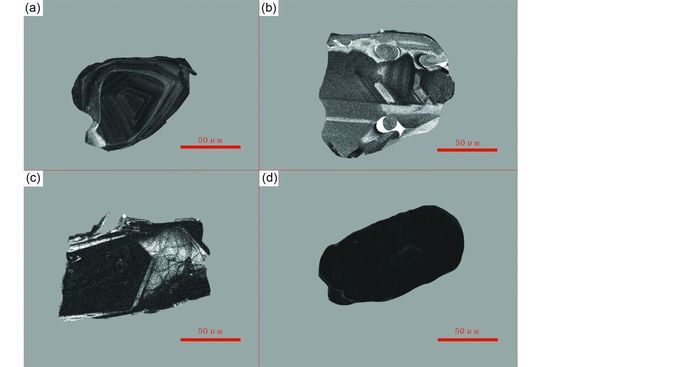
|
图 12 叶蜡石中锆石阴极发光图 (a)锆石环带发育,边部受溶蚀影响发育不规则边缘;(b)锆石内部发育的球形溶蚀边;(c)锆石边缘明显破碎,内部发育大量的裂隙;(d)锆石受热液蚀变影响,环带消失;锆石颗粒Th、U含量升高导致阴极发光变暗,这与叶蜡石矿石的Th、U含量升高特征吻合 Fig. 12 Representative CL zircon images from the pyrophyllite ores (a) zircon developed rhythmatic zonings, with irregular edges affected by fluid dissolutions; (b) spherical dissolution edges were developed inside of zircon; (c) visible damages were developed in the edges and cracks in zircon; (d) the rhythmatic zones disappeared by the effect of hydrothermal fluids; the increasing contents of Th and U leading to poor intensity of CL images, highly consistent with increasing of Th and U contents in the pyrophyllite ores |
REE在岩石中主要受控于锆石、榍石和褐帘石等副矿物(Gromet and Silver, 1983),其迁移率主要受络合离子,如CO32-、PO43-、F-、SO42-和Cl-以及低pH和高水岩比的控制(Michard, 1989; Wood, 1990),并且在酸性条件下优先与SO42-和Cl-结合(Wood, 1990; Haas et al., 1995) 。所以,流体对REE的溶解能力随着pH值的降低而升高并导致蚀变岩的REE含量会逐渐降低(Michard, 1989) 。与LREE相比,HREE能形成更稳定的络合物(Pirajno, 2012;Takahashi et al., 2004) 。因此,在蚀变过程中,重稀土通常较轻稀土稳定,导致蚀变岩的(La/Yb)N比值降低和YbN的升高。本文的叶蜡石矿石与围岩绢云钠长石英片岩相比,稀土元素整体呈迁出状态,且迁出量从La到Yb呈逐渐减少的趋势,Eu负异常呈明显增大趋势,这与酸性流体中稀土元素地球化学行为吻合(Pirajno, 2012) 。含REE矿物指数(Zr+Y+(P2O5+TiO2)×10) 与∑REE之间的相关性图解显示(图 10d),随着样品REE总量的下降,含REE矿物指数也随之下降,说明叶蜡石中REE总量的降低可能与副矿物溶解或分解有关,如锆石、榍石、磷灰石等。
总之,本文结果显示在叶蜡石蚀变过程中,稀土和不活动的高场强元素发生了明显地活动特征,如Zr、Hf、Nb、Ta等。而且,一般认为相对稳定的元素Th、Ti、P等元素也发生了明显地活动。
前文述及,叶蜡石化蚀变流体为一强酸性的流体,对比叶蜡石与绢云钠长石英片岩中的金属元素含量可知,金属元素Au、As在蚀变过程中被活化带出,导致叶蜡石中的Au、As含量极大降低,这些富含金属元素的蚀变后流体继续向上运移,而对于早期流体蚀变形成的金矿化具有破坏现象。叶蜡石矿石中广泛发育有港湾状赤铁矿(图 5n, o),说明黄铁矿在叶蜡石化过程中不稳定。这可能与叶蜡石化流体高氧逸度导致赤铁矿化和溶解有关。而早期Au、As等元素主要赋存在黄铁矿中,因黄铁矿的分解或者转化后,这些元素被酸性高氧逸度的流体携带迁出。
6 结论(1) 五台白云叶蜡石矿围岩蚀变分带主要有黄铁绢英岩化与叶蜡石化。本区金矿化主要集中在黄铁绢英岩化带内,且主要位于强弱黄铁绢英岩化分带处。晚期的叶蜡石化叠加于早期的黄铁绢英岩化之上,主要矿物组合为叶蜡石+伊利石+高岭石+石英。Log fO2-pH热力学相图模拟显示早期黄铁绢云岩化发生金矿化的条件在弱酸性至偏中性(pH=5.24~5.87)和较低氧逸度(位于黄铁矿+黄铜矿稳定相区)条件下;而引起叶蜡石化蚀变的热液具有强酸性(pH=2.07~2.20)和较高的氧逸度(位于HM缓冲线以上)特征。
(2) 在这种强酸性、高氧逸度的叶蜡石化蚀变流体作用下,岩石中Al2O3表现较为稳定,主要的氧化物如SiO2、K2O、Na2O表现为迁入而其余TiO2、CaO、Fe2O3T、MgO和P2O5表现为迁出;微量元素Sr、Ba、Zr、Hf明显迁出,Zr/Hf解耦且比值降低,Nb、Ta、Th、U、Rb、Ga和Y呈相对迁入状态,其中Nb/Ta比值稍有下降,Th/U比值稍有上升,Y/Ho比值升高。稀土元素整体呈迁出状态且迁出量从La到Yb有逐渐降低的趋势。大量的金属元素,如Au、As等,在叶蜡石化过程中被活化带出,说明叶蜡石化过程中的高氧逸度和强酸性流体对金属元素的溶解度增大,不利于Au的沉淀。
致谢 衷心感谢中国地质大学(北京)地球科学与资源学院翟德高博士和中国科学院地质与地球物理研究所刘玄博士对本文的批评指正。感谢许元全、刘鹏杰、张义、张萌萌等硕士研究生共同野外工作。| [] | Aja SU, Wood SA, Williams-Jones AE. 1995. The aqueous geochemistry of Zr and the solubility of some Zr-bearing minerals. Applied Geochemistry, 10(6): 603–620. DOI:10.1016/0883-2927(95)00026-7 |
| [] | Alderton DHM, Pearce JA, Potts PJ. 1980. Rare earth element mobility during granite alteration: Evidence from southwest England. Earth and Planetary Science Letters, 49(1): 149–165. DOI:10.1016/0012-821X(80)90157-0 |
| [] | Bai J. 1986. The Early Precambrian Geology of Wutaishan. Tianjin: Tianjin Science and Technology Press: 1-475. |
| [] | Bai J, Wang RZ, Guo JJ. 1992. The Major Geological Events of Early Precambrian and Their Dating in Wutaishan. Beijing: Geological Publishing Press. |
| [] | Baker JH. 1985. Rare earth and other trace element mobility accompanying albitization in a Proterozoic granite, W. Bergslagen, Sweden. Mineralogical Magazine, 49(350): 107–115. DOI:10.1180/minmag |
| [] | Blackburn WH, Metcalf RV, Ragland PC. 1994. Geochemical evolution of the Precambrian Old Rag Granite, Virginia, U. S.A.: Testing a U-Th exploration model. Chemical Geology, 111(1-4): 177–206. |
| [] | Brendebach B, Altmaier M, Rothe J, Neck V, Denecke MA. 2007. EXAFS study of aqueous ZrIV and ThIV complexes in alkaline CaCl2 solutions: Ca3[Zr(OH)6]+4 and Ca4[Th(OH)8]+4. Inorganic Chemistry, 46(16): 6804–6810. DOI:10.1021/ic070318t |
| [] | Brown AJ, Cudahy TJ, Walter MR. 2006. Hydrothermal alteration at the Panorama formation, North Pole dome, Pilbara craton, Western Australia. Precambrian Research, 151(3): 211–223. |
| [] | Charoy B, Raimbault L. 1994. Zr-, Th-, and REE-rich biotite differentiates in the A-type granite pluton of Suzhou (eastern China): The key role of fluorine. Journal of Petrology, 35(4): 919–962. DOI:10.1093/petrology/35.4.919 |
| [] | Chen B, Zhai MG. 2003. Geochemistry of Late Mesozoic lamprophyre dykes from the Taihang Mountains, North China, and implications for the sub-continental lithospheric mantle. Geological Magazine, 140: 87–93. DOI:10.1017/S0016756802007124 |
| [] | Cooke DR, Simmons SF. 2000. Characteristics and genesis of epithermal gold deposits. Reviews in Economic Geology, 13(12): 221–244. |
| [] | Dempster TJ, Hay DC, Bluck BJ. 2004. Zircon growth in slate. Geology, 32(3): 221–224. DOI:10.1130/G20156.1 |
| [] | Du LL, Yang CH, Guo JH, Wang W, Ren LD, Wan YS, Geng YS. 2010. The age of the base of the Paleoproterozoic Hutuo Group in the Wutai Mountains area, North China Craton: SHRIMP zircon U-Pb dating of basaltic andesite. Chinese Science Bulletin, 55(17): 1782–1789. DOI:10.1007/s11434-009-3611-8 |
| [] | Du LL, Yang CH, Wang W, Ren LD, Wan YS, Song HX, Geng YS, Hou KJ. 2011. The re-examination of the age and stratigraphic subdivision of the Hutuo Group in the Wutai Mountains area, North China Craton: Evidences from geology and zircon U-Pb geochronology. Acta Petrologica Sinica, 27(4): 1037–1055. |
| [] | Du LL, Yang CH, Wang W, Ren LD, Wan YS, Wu JS, Zhao L, Song HX, Geng YS, Hou KJ. 2013. Paleoproterozoic rifting of the North China Craton: Geochemical and zircon Hf isotopic evidence from the 2137Ma Huangjinshan A-type granite porphyry in the Wutai area. Journal of Asian Earth Sciences, 72: 190–202. DOI:10.1016/j.jseaes.2012.11.040 |
| [] | Evans BW, Guggenheim S. 1988. Talc, pyrophyllite, and related minerals. Reviews in Mineralogy and Geochemistry, 19(1): 225–294. |
| [] | Fourcade S, Allegre CJ. 1981. Trace elements behavior in granite genesis: A case study the calc-alkaline plutonic association from the Querigut complex (Pyrénées, France). Contributions to Mineralogy and Petrology, 76(2): 177–195. DOI:10.1007/BF00371958 |
| [] | Gammons CH, Williams-Jones AE. 1997. Chemical mobility of gold in the porphyry-epithermal environment. Economic Geology, 92(1): 45–59. DOI:10.2113/gsecongeo.92.1.45 |
| [] | Gong QJ, Deng J, Yang LQ, Zhang J, Wang QF, Zhang GX. 2011. Behavior of major and trace elements during weathering of sericite-quartz schist. Journal of Asian Earth Sciences, 42(1-2): 1–13. DOI:10.1016/j.jseaes.2011.03.003 |
| [] | Grant JA. 1986. The isocon diagram: A simple solution to Gresens' equation for metasomatic alteration. Economic Geology, 81(8): 1976–1982. DOI:10.2113/gsecongeo.81.8.1976 |
| [] | Grant JA. 2005. Isocon analysis: A brief review of the method and applications. Physics and Chemistry of the Earth, Parts A/B/C, 30(17-18): 997–1004. DOI:10.1016/j.pce.2004.11.003 |
| [] | Gresens RL. 1967. Composition-volume relationships of metasomatism. Chemical Geology, 2: 47–65. DOI:10.1016/0009-2541(67)90004-6 |
| [] | Gromet LP, Silver LT. 1983. Rare earth element distributions among minerals in a granodiorite and their petrogenetic implications. Geochimica et Cosmochimica Acta, 47(5): 925–939. DOI:10.1016/0016-7037(83)90158-8 |
| [] | Guo S, Ye K, Chen Y, Liu JB, Zhang LM. 2013. Introduction of mass-balance calculation method for component transfer during the opening of a geological system. Acta Petrologica Sinica, 29(5): 1486–1498. |
| [] | Haas JR, Shock EL, Sassani DC. 1995. Rare earth elements in hydrothermal systems: Estimates of standard partial molal thermodynamic properties of aqueous complexes of the rare earth elements at high pressures and temperatures. Geochimica et Cosmochimica Acta, 59(21): 4329–4350. DOI:10.1016/0016-7037(95)00314-P |
| [] | Hemley JJ, Montoya JW, Marinenko JW, Luce RW. 1980. Equilibria in the system Al2O3-SiO2-H2O and some general implications for alteration/mineralization processes. Economic Geology, 75(2): 210–228. DOI:10.2113/gsecongeo.75.2.210 |
| [] | Hildebrand FA. 1961. Hydrothermally altered rocks in eastern Puerto Rico. US Geological Survey Professional Paper, 424: B219–B221. |
| [] | Jiang N, Sun SH, Chu XL, Mizuta T, Ishiyama D. 2003. Mobilization and enrichment of high-field strength elements during late- and post-magmatic processes in the Shuiquangou syenitic complex, northern China. Chemical Geology, 200(1-2): 117–128. DOI:10.1016/S0009-2541(03)00162-1 |
| [] | Johnson JW, Oelkers EH, Helgeson HC. 1992. SUPCRT92: A software package for calculating the standard molal thermodynamic properties of minerals, gases, aqueous species, and reactions from 1 to 5000 bar and 0 to 1000℃. Computers & Geosciences, 18(7): 899–947. |
| [] | Kröner A, Wilde SA, Li JH, Wang KY. 2004. Age and evolution of a Late Archaean to Early Paleozoic upper to Lower crustal section in the Wutaishan/Hengshan terrain of northern China. Journal of Asian Earth Sciences, 24(5): 577–595. |
| [] | Kröner A, Wilde SA, O'Brien PJ, Li JH, Passchier CW, Walte NP, Liu DY. 2005. Field relationships, geochemistry, zircon ages and evolution of a Late Archaean to Paleoproterozoic lower crustal section in the Hengshan Terrain of northern China. Acta Geologica Sinica, 79(5): 605–629. |
| [] | Li JX, Qian XL. 1991. A study on the Longquanguan shear zone in the northern part of the Taihang Mountains. Shanxi Geology, 6(1): 17–29. |
| [] | Li JL, Wang KY, Wang QC, Liu XH, Zhao ZY. 1990. Early Proterozoic collision belt in the Wutaishan area, China. Scientia Geologica Sinica, 25(1): 1–11. |
| [] | Li QG, Liu SW, Wang ZQ, Chu ZY, Song B, Wang YB, Wang T. 2008. Contrasting provenance of Late Archean metasedimentary rocks from the Wutai Complex, North China Craton: detrital zircon U-Pb, whole-rock Sm-Nd isotopic, and geochemical data. International Journal of Earth Sciences, 97(3): 443–458. DOI:10.1007/s00531-007-0170-6 |
| [] | Li XC, Fan HR, Santosh M, Hu FF, Yang KF, Lan TG. 2013. Hydrothermal alteration associated with Mesozoic granite-hosted gold mineralization at the Sanshandao deposit, Jiaodong Gold Province, China. Ore Geology Reviews, 53: 403–421. DOI:10.1016/j.oregeorev.2013.01.020 |
| [] | Liu CH, Zhao GC, Liu FL, Shi JR. 2016a. Constraints of volcanic rocks of the Wutai Complex (Shanxi Province, northern China) on a giant Late Neoarchean intra-oceanic arc system in the Trans-North China Orogen. Journal of Asian Earth Sciences, 123: 178–212. DOI:10.1016/j.jseaes.2016.04.006 |
| [] | Liu CH, Liu FL, Shi JR, Liu PH, Yang H, Liu LS, Wang W, Tian ZH. 2016b. Depositional age and provenance of the Wutai Group: Evidence from zircon U-Pb and Lu-Hf isotopes and whole-rock geochemistry. Precambrian Research, 281: 269–290. DOI:10.1016/j.precamres.2016.06.002 |
| [] | Liu DY, Page RW, Compston W, Wu JS. 1985. U-Pb zircon geochronology of Late Archaean metamorphic rocks in the Taihangshan-Wutaishan area, North China. Precambrian Research, 27(1-3): 85–109. DOI:10.1016/0301-9268(85)90007-5 |
| [] | Liu SW, Pan YM, Xie QL, Zhang J, Li QG. 2004. Archean geodynamics in the Central Zone, North China Craton: Constraints from geochemistry of two contrasting series of granitoids in the Fuping and Wutai complexes. Precambrian Research, 130(1-4): 229–249. DOI:10.1016/j.precamres.2003.12.001 |
| [] | Lu J. 2009. Lithogeochemistry and mineralogical mapping of the Dongyaozhuang gold deposit in Wutai County, Shanxi Province. Beijing: China University of Geosciences. |
| [] | MacLean WH. 1988. Rare earth element mobility at constant inter-REE ratios in the alteration zone at the Phelps Dodge massive sulphide deposit, Matagami, Quebec. Mineralium Deposita, 23(4): 231–238. DOI:10.1007/BF00206399 |
| [] | Miao PS, Zhang ZF, Zhang JZ, Zhao ZX, Xu SC. 1999. Paleoproterozoic stratigraphic sequence in the Wutai Mountain area. Regional Geology of China, 18(4): 405–413. |
| [] | Michard A. 1989. Rare earth element systematics in hydrothermal fluids. Geochimica et Cosmochimica Acta, 53(3): 745–750. DOI:10.1016/0016-7037(89)90017-3 |
| [] | Mikucki EJ. 1998. Hydrothermal transport and depositional processes in Archean lode-gold systems: A review. Ore Geology Reviews, 13(1-5): 307–321. DOI:10.1016/S0169-1368(97)00025-5 |
| [] | Nesbitt RW, Pascual E, Fanning CM, Toscano M, Sáez r, Almodóvar GR. 1999. U-Pb dating of stockwork zircons from the eastern Iberian Pyrite Belt. Journal of the Geological Society, 156(1): 7–10. DOI:10.1144/gsjgs.156.1.0007 |
| [] | Noyes HJ, Frey FA, Wones DR. 1983. A tale of two plutons: Geochemical evidence bearing on the origin and differentiation of the Red Lake and Eagle Peak plutons, central Sierra Nevada, California. The Journal of Geology, 91(5): 487–509. DOI:10.1086/628801 |
| [] | Peng P, Zhai MG, Zhang HF, Guo JH. 2005. Geochronological constraints on the Paleoproterozoic evolution of the North China Craton: SHRIMP zircon ages of different types of mafic dikes. International Geology Review, 47(5): 492–508. DOI:10.2747/0020-6814.47.5.492 |
| [] | Pirajno F. 2012. Hydrothermal Mineral Deposits: Principles and Fundamental Concepts for the Exploration Geologist. . |
| [] | Polat A, Kusky T, Li JH, Fryer B, Kerrich R, Patrick K. 2005. Geochemistry of Neoarchean (ca. 2.55~2.50Ga) volcanic and ophiolitic rocks in the Wutaishan greenstone belt, central orogenic belt, North China craton: Implications for geodynamic setting and continental growth. Geological Society of America Bulletin, 117: 1387–1399. |
| [] | Qi DM, Zhou HW, Gong YJ, Xiong SF, Jia D, Zhang J, Zhang MY. 2015. Element mobility during the fluid-rock hydrothermal alteration: Evidence from altered porphyritic granite in Ⅳ pipe of the Qiyugou gold deposit, Henan Province. Acta Petrologica Sinica, 31(9): 2655–2673. |
| [] | Qian JH, Wei CJ, Zhou XW, Zhang YH, Chu H. 2013. Geochemistry of garnet-mica schist in the Wutai Group and its implications. Acta Petrologica et Mineralogica, 32(4): 405–416. |
| [] | Rasmussen B. 2005. Zircon growth in very low grade metasedimentary rocks: Evidence for zirconium mobility at~ 250℃. Contributions to Mineralogy and Petrology, 150(2): 146–155. DOI:10.1007/s00410-005-0006-y |
| [] | Roaldset E. 1975. Rare earth element distributions in some Precambrian rocks and their phyllosilicates, Numedal, Norway. Geochimica et Cosmochimica Acta, 39(4): 455–469. DOI:10.1016/0016-7037(75)90100-3 |
| [] | Rubin JN, Henry CD, Price JG. 1993. The mobility of zirconium and other "immobile" elements during hydrothermal alteration. Chemical Geology, 110(1-3): 29–47. DOI:10.1016/0009-2541(93)90246-F |
| [] | Rusk B, Koenig A, Lowers H. 2011. Visualizing trace element distribution in quartz using cathodoluminescence, electron microprobe, and laser ablation-inductively coupled plasma-mass spectrometry. American Mineralogist, 96(5-6): 703–708. DOI:10.2138/am.2011.3701 |
| [] | Sasaki T, Kobayashi T, Takagi I, Moriyama H. 2006. Solubility measurement of zirconium (IV) hydrous oxide. Radiochimica Acta, 94(9-11): 489–494. |
| [] | Salvi S, Williams-Jones AE. 1996. The role of hydrothermal processes in concentrating high-field strength elements in the Strange Lake peralkaline complex, northeastern Canada. Geochimica et Cosmochimica Acta, 60(11): 1917–1932. DOI:10.1016/0016-7037(96)00071-3 |
| [] | Scott KM. 2005. Rutile geochemistry as a guide to porphyry Cu-Au mineralization, Northparkes, New South Wales, Australia. Geochemistry: Exploration, Environment, Analysis, 5(3): 247–253. DOI:10.1144/1467-7873/03-055 |
| [] | Seedorff E, Dilles JH, Proffett JM, Einaudi MT, Zurcher L, Stavast WJA, Barton MD, Johnson DA. 2005. Porphyry deposits: Characteristics and origin of hypogene features. Economic Geology 100th Anniversary Volume, 29: 251–298. |
| [] | Sharma RP. 1979. Origin of the pyrophyllite-diaspore deposits of the Bundelkhand Complex, central India. Mineralium Deposita, 14(3): 343–352. |
| [] | Sinyakovskaya I, Zaykov V, Kitagawa R. 2005. Types of pyrophyllite deposits in foldbelts. Resource Geology, 55: 405–418. DOI:10.1111/rge.2005.55.issue-4 |
| [] | Sun M, Armstrong RL, Lambert RSJ. 1992. Petrochemistry and Sr, Pb, and Nd isotopic geochemistry of Early Precambrian rocks, Wutaishan and Taihangshan areas, China. Precambrian Research, 56(1-2): 1–31. DOI:10.1016/0301-9268(92)90081-X |
| [] | Sun SS, McDonough WF. 1989. Chemical and isotopic systematics of oceanic basalts: Implications for mantle composition and processes. In: Saunders AD and Norry MJ (eds.). Magmatism in the Ocean Basins. Geological Society, London, Special Publications, 42(1): 313–345. DOI:10.1144/GSL.SP.1989.042.01.19 |
| [] | Sun WL, Niu YL, Ma YX, Liu Y, Zhang GR, Hu ZX, Zhang ZW, Chen S, Li JY, Wang XL, Gong HM. 2015. Petrogenesis of the Chagangnuoer deposit, NW China: A general model for submarine volcanic-hosted skarn iron deposits. Science Bulletin, 60(3): 363–379. DOI:10.1007/s11434-014-0684-9 |
| [] | Sverjensky DA, Hemley JJ, D'angelo WM. 1991. Thermodynamic assessment of hydrothermal alkali feldspar-mica-aluminosilicate equilibria. Geochimica et Cosmochimica Acta, 55(4): 989–1004. DOI:10.1016/0016-7037(91)90157-Z |
| [] | Takahashi Y, Tada A, Shimizu H. 2004. Distribution pattern of rare earth ions between water and montmorillonite and its relation to the sorbed species of the ions. Analytical Sciences, 20(9): 1301–1306. DOI:10.2116/analsci.20.1301 |
| [] | Terakado Y, Fujitani T. 1998. Behavior of the rare earth elements and other trace elements during interactions between acidic hydrothermal solutions and silicic volcanic rocks, southwestern Japan. Geochimica et Cosmochimica Acta, 62(11): 1903–1917. DOI:10.1016/S0016-7037(98)00109-4 |
| [] | Tian YQ. 1991. Geology and Gold Mineralization of Wutai-Hengshan Greenstone Belt. Taiyuan: Shanxi Science and Technology Press: 1-44. |
| [] | Tian YQ, Wang AJ, Yu KR, Xu WL. 1998. Geodynamics of the vein gold mineralization in the Wutaishan-Hengshan terrain, Shanxi Province. North China J. Geol. Miner. Resour., 13: 301–456. |
| [] | Valsami-Jones E, Ragnarsdóttir KV. 1997. Controls on uranium and thorium behaviour in ocean-floor hydrothermal systems: Examples from the Pindos ophiolite, Greece. Chemical Geology, 135(3-4): 263–274. DOI:10.1016/S0009-2541(96)00121-0 |
| [] | Van Dongen M, Weinberg RF, Tomkins AG. 2010. REE-Y, TI, and P remobilization in magmatic rocks by hydrothermal alteration during Cu-Au deposit formation. Economic Geology, 105(4): 763–776. DOI:10.2113/gsecongeo.105.4.763 |
| [] | Wan YS, Miao PS, Liu DY, Yang CH, Wang W, Wang HC, Wang ZJ, Dong CY, Du LL, Zhou HY. 2010. Formation ages and source regions of the Palaeoproterozoic Gaofan, Hutuo and Dongjiao groups in the Wutai and Dongjiao areas of the North China Craton from SHRIMP U-Pb dating of detrital zircons: Resolution of debates over their stratigraphic relationships. Chinese Science Bulletin, 55(13): 1278–1284. DOI:10.1007/s11434-009-0615-3 |
| [] | Wang CY, Li XF, Xiao R, Bai YP, Yang F, Mao W, Jiang SK. 2012. Elements mobilization of mineralized porphyry rocks during hydrothermal alteration at Zhushahong porphyry copper deposit, Dexing district, South China. Acta Petrologica Sinica, 28(12): 3869–3886. |
| [] | Wang KY, Hao J, Wilde SA, Cawood PA. 2000. Reconsideration of some key geological problems of Late Archean-Early Proterozoic in the Wutaishan-Hengshan area: Constraints from SHRIMP U-Pb zircon data. Scientia Geologica Sinica, 35(2): 175–184. |
| [] | Wang ZH, Wilde SA, Wang KY, Yu LJ. 2004. A MORB-arc basalt-adakite association in the 2. 5Ga Wutai greenstone belt: Late Archean magmatism and crustal growth in the North China Craton. Precambrian Research, 131(3): 323–343. |
| [] | Wang ZH. 2009. Tectonic evolution of the Hengshan-Wutai-Fuping complexes and its implication for the Trans-North China Orogen. Precambrian Research, 170(1): 73–87. |
| [] | Watson EB, Harrison TM. 1983. Zircon saturation revisited: temperature and composition effects in a variety of crustal magma types. Earth and Planetary Science Letters, 64(2): 295–304. DOI:10.1016/0012-821X(83)90211-X |
| [] | Whitney DL, Evans BW. 2010. Abbreviations for names of rock-forming minerals. American Mineralogist, 95(1): 185–187. DOI:10.2138/am.2010.3371 |
| [] | Wilde SA, Cawood P and Wang KY. 1997. The relationship and timing of granitoid evolution with respect to felsic volcanism in the Wutai Complex, North China Craton. In: Precambrian Geology and Metamorphic Petrology: Proceedings of the 30th International Geological Congress. Beijing, China: VSP International Science Publishers, 75 |
| [] | Wilde SA, Cawood PA, Wang KY, Nemchin A, Zhao GC. 2004. Determining Precambrian crustal evolution in China: A case-study from Wutaishan, Shanxi Province, demonstrating the application of precise SHRIMP U-Pb geochronology. In: Malpas J, Fletcher CJN, Ali JR and Aitchison JC (eds). Aspects of the Tectonic Evolution of China. Geological Society, London, Special Publications, 226(1): 5–25. |
| [] | Wilde SA, Zhao GC. 2005. Archean to Paleoproterozoic evolution of the North China craton. Journal of Asian Earth Sciences, 24: 519–522. DOI:10.1016/j.jseaes.2004.06.004 |
| [] | Wilde SA, Cawood PA, Wang KY, Nemchin AA. 2005. Granitoid evolution in the Late Archean Wutai Complex, North China Craton. Journal of Asian Earth Sciences, 24(5): 597–613. DOI:10.1016/j.jseaes.2003.11.006 |
| [] | Wood SA. 1990. The aqueous geochemistry of the rare-earth elements and yttrium: 2. Theoretical predictions of speciation in hydrothermal solutions to 350℃ at saturation water vapor pressure. Chemical Geology, 88(1-2): 99–125. |
| [] | Wu CH, Zhong CT. 1998. The Paleoproterozoic SW-NE collision model for the central North China Carton. Progress in Precambrian Research, 21(3): 28–50. |
| [] | Zen EA. 1961. Mineralogy and petrology of the Al2O3-SiO2-H2O in some pyrophyllite deposits of North Carolina. American Mineralogist, 46(1-2): 52–66. |
| [] | Zhang J, Zhao GC, Li SZ, Sun M, Liu SW, Yin CQ. 2009. Deformational history of the Fuping Complex and new U-Th-Pb geochronological constraints: Implications for the tectonic evolution of the Trans-North China Orogen. Journal of Structural Geology, 31: 177–193. DOI:10.1016/j.jsg.2008.11.008 |
| [] | Zhang HD, Zhang HF, Santosh M, Li SR. 2014. Fluid inclusions from the Jinchang Cu-Au deposit, Heilongjiang Province, NE China: Genetic style and magmatic-hydrothermal evolution. Journal of Asian Earth Sciences, 82: 103–114. DOI:10.1016/j.jseaes.2013.12.017 |
| [] | Zhao GC, Wilde SA, Cawood PA, Sun M. 2001. Archean blocks and their boundaries in the North China Craton: Lithological, geochemical, structural and P-T path constraints and tectonic evolution. Precambrian Research, 107(1): 45–73. |
| [] | Zhao GC, Kröner A, Wilde SA, Sun M, Li SZ, Li XP, Zhang J, Xia XP, He YH. 2007. Lithotectonic elements and geological events in the Hengshan-Wutai-Fuping belt: A synthesis and implications for the evolution of the Trans-North China Orogen. Geological Magazine, 144(05): 753–775. |
| [] | Zhu YF, An F, Tan JJ. 2011. Geochemistry of hydrothermal gold deposits: A review. Geoscience Frontiers, 2(3): 367–374. DOI:10.1016/j.gsf.2011.05.006 |
| [] | 白瑾. 1986. 五台山早前寒武纪地质. 天津: 天津科学技术出版社: 1-475. |
| [] | 白瑾, 王汝铮, 郭进京. 1992. 五台山早前寒武纪重大地质事件及其年代. 北京: 地质出版杜. |
| [] | 杜立林, 杨崇辉, 王伟, 任留东, 万渝生, 宋会侠, 耿元生, 侯可军. 2011. 五台地区滹沱群时代与地层划分新认识:地质学与锆石年代学证据. 岩石学报, 27(4): 1037–1055. |
| [] | 郭顺, 叶凯, 陈意, 刘景波, 张灵敏. 2013. 开放地质体系中物质迁移质量平衡计算方法介绍. 岩石学报, 29(5): 1486–1498. |
| [] | 卢静. 2009. 山西省五台县东腰庄金矿岩石地球化学特征与矿物学填图. 硕士学位论文. 北京: 中国地质大学 |
| [] | 李江海, 钱祥麟. 1991. 太行山北段龙泉关剪切带研究. 山西地质, 6(1): 17–29. |
| [] | 李继亮, 王凯怡, 王清晨, 刘小汉, 赵中岩. 1990. 五台山早元古代碰撞造山带初步认识. 地质科学, 25(1): 1–11. |
| [] | 苗培森, 张振福, 张建中, 赵祯祥, 续世朝. 1999. 五台山区早元古代地层层序探讨. 中国区域地质, 18(4): 405–413. |
| [] | 祁冬梅, 周汉文, 宫勇军, 熊索菲, 贾耽, 张金, 张旻玥. 2015. 岩石热液蚀变作用过程元素的活动性——河南祁雨沟金矿Ⅳ号岩体蚀变花岗斑岩的研究. 岩石学报, 31(9): 2655–2673. |
| [] | 钱加慧, 魏春景, 周喜文, 张颖慧, 初航. 2013. 五台岩群石榴云母片岩地球化学特征及其地质意义. 岩石矿物学杂志, 32(4): 405–416. |
| [] | 田永清. 1991. 五台山-恒山绿岩带地质及金的成矿作用. 太原: 山西科技出版社: 1-44. |
| [] | 田永清, 王安建, 余克忍, 许文良. 1998. 山西省五台山-恒山地区脉状金矿成矿的地球动力学. 华北地质矿产杂志, 13(4): 342–343. |
| [] | 王翠云, 李晓峰, 肖荣, 白艳萍, 杨锋, 毛伟, 将松坤. 2012. 德兴朱砂红斑岩铜矿热液蚀变作用及元素地球化学迁移规律. 岩石学报, 28(12): 3869–3886. |
| [] | 王凯怡, 郝杰, WildeSA, CawoodPA. 2000. 山西五台山-恒山地区晚太古-早元古代若干关键地质问题的再认识: 单颗粒锆石离子探针质谱年龄提出的地质制约. 地质科学, 35(2): 175–184. |
| [] | 吴昌华, 钟长汀. 1998. 华北陆台中段吕梁期的SW-NE向碰撞-晋蒙高级区孔兹岩系进入下地壳的构造机制. 前寒武纪研究进展, 21(3): 28–50. |
 2017, Vol. 33
2017, Vol. 33




